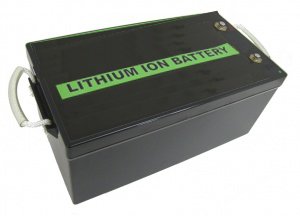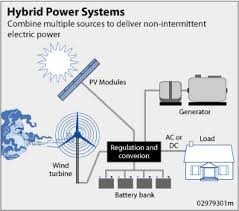
How Batteries are Used in Home Power
In order for a home power system to provide a constant energy source it would need a battery backup system. The entire energy system is tied to the output of the alternative energy providers with a bank of batteries for storage capability. If the system is relying on solar and wind power there will be many times when these options are not available to provide sufficient energy needs. The geothermal system is capable of providing temperature source but a battery storage system would optimize the overall home hybrid energy design. A standby generator is an option to be used in certain conditions, however the best way to run a hybrid system is through the integration of a battery storage bank. By running the output of renewable power providers through charge controllers and into a battery bank, power can be available 24 hours a day, regardless of weather conditions. Wind turbines and solar panels can deliver power to the battery bank and excess power can be stored during low use times generally the middle of the day and middle of the night. Power will then be available during high use times usually morning and evening..
What Should I Know about Battery Storage?
With so many battery-powered devices available today, following proper battery storage practices is important for nearly everyone. Chemical batteries vary greatly in shelf life so it is vital that batteries be stored in ways that maximize their usefulness.
Types of Batteries
Lead Acid Automotive Batteries
Automotive batteries are designed to deliver a relatively high amount of current in a short period of time, but should never be heavily discharged. Automotive batteries have a highly porous plate with large holes and a wide surface area to enable a sudden high current output. Automotive batteries are not good choices for these applications because home power systems require repeated deep discharges of stored power,
Golf Cart Batteries are more expensive than deep cycle recreational batteries but are very popular for small systems. Most are generally 6 volt and have capacities in the 220-300 amp-hour range. They are designed for deep discharge cycles and will tend to have longer lifespans in a residential alternative energy system. They are also less sensitive to mild overcharging are generally cheaper per amp-hour than RV type batteries. Most home power systems are 12 volt so two 6 volt batteries must be connected in series. They are also unsealed and must be used in a well ventilated area. They will require periodic water replacement.
RV/Marine Batteries can be found in “sealed” or standard servicable types, and are commonly used in small home power or portable power applications. RV/Marine batteries are generally small, compact and easy to handle and install. They are usually 12 volt, available in a variety of capacities up to 100 amp-hours, and are relatively inexpensive. The sealed type batteries are non-spillable and safer for indoor applications. These batteries are not designed for very heavy cycling so their life-spans are often shorter than other types of deep cycle batteries. Sealed batteries are also very sensitive to overcharging, which may further shorten their useful lifespan. This type of battery must be wired in parallel to obtain more than 100 amp-hours of storage and this is less efficient than using a single high capacity battery.
Industrial Strength Batteries
Three types of the heavier industrial type batteries are the flooded types such as lead acid batteries, gel types and absorbed glass mat batteries.
- Flooded types have caps to add water, work well for many years and are reasonably priced. Some manufacturers that make these types for Solar Energy are Trojan, Surrette, and Deka. All flooded batteries release gases which can be explosive. When installed in an enclosure the gases should be vented to avoid a dangerous buildup of fumes.
- Gel Type Batteries. These are not maintenance free batteries. They have no vents and do not release gas when charging. You don’t need to ventilate these and they can be used indoors. Since indoor temperature can be maintained the batteries will perform better.
- Absorbed Glass Mat batteries are probably the best choice for Solar power use. They have a woven glass material in between the plate which holds the charge better. They are sealed, do not discharge gas, maintain voltage better and last longer. Concorde Battery makes a series of AGM batteries that provides excellent service.
Industrial/Stationary Batteries due to their extremely high amp-hour capacities will have a significantly higher initial cost. They are normally manufactured as individual 2 volt units which are then combined to create the necessary voltage for any power system. A very high amp hour capacity can be obtained with a single six cell set and charging characteristics are very stable. These batteries can weigh up to 350 lbs. per two volt cell and will likely require special transporting assistance.. This type of battery will have the longest average lifespan under deep cycling home power conditions. They’re available in a wide variety of capacities up to 3000 amp-hours
Nickel Alloy Batteries Nickel Cadmium (NiCad) and Nickel Iron batteries are a good choice for home power use but are much more expensive than other types. They use nickel alloy plates submerged in an alkaline solution rather than a lead acid arrangement. Nickel alloy batteries can last up to 50 years compared to lead acid batteries and can rest for long periods of time without being damaged. They can be heavily discharged repeatedly without suffering damage and operate better at lower temperatures. They can be a little tricky with power compatibility however and battery management must be closely monitored.




No Comments Yet